
Jagannatha is a deity worshipped in regional Hindu traditions in India and Bangladesh as part of a triad along with his brother Balabhadra, and sister, Subhadra. Jagannath, within Odia Hinduism, is the supreme god, Purushottama, and the Para Brahman. To most Vaishnava Hindus, particularly the Krishnaites, Jagannath is an abstract representation of Krishna, or Vishnu, sometimes as the avatar of Krishna or Vishnu. To some Shaiva and Shakta Hindus, he is a symmetry-filled tantric form of Bhairava, a fierce manifestation of Shiva associated with annihilation.

Puri is a coastal city and a municipality in the state of Odisha in eastern India. It is the district headquarters of Puri district and is situated on the Bay of Bengal, 60 kilometres (37 mi) south of the state capital of Bhubaneswar. It is also known as Sri Jagannatha Dhama after the 12th-century Jagannath Temple located in the city. It is one of the original Char Dham pilgrimage sites for Hindus.
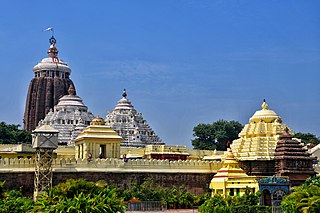
The Jagannath Temple is an important Hindu temple dedicated to Jagannath, a form of Vishnu – one of the trinity of supreme divinity in Hinduism. Puri is in the state of Odisha, on the eastern coast of India. King Indradyumna of Avanti has built the main temple of Jagannath at Puri. The present temple was rebuilt from the tenth 10th century onwards, on the site of pre-existing temples in the compound but not the main Jagannatha temple, and begun by Anantavarman Chodaganga, the first king of the Eastern Ganga dynasty. many rumours are spread about the temple but there is no solid proof of it. The temple is one of the 108 Abhimana Kshethram of Vaishnavate tradition.

Yātrā, in Indian-origin religions, Hinduism, Buddhism, Jainism and Sikhism, generally means a pilgrimage to holy places such as confluences of sacred rivers, sacred mountains, places associated with Hindu epics such as the Mahabharata and Ramayana, and other sacred pilgrimage sites. Visiting a sacred place is believed by the pilgrim to purify the self and bring one closer to the divine. The journey itself is as important as the destination, and the hardships of travel serve as an act of devotion in themselves.
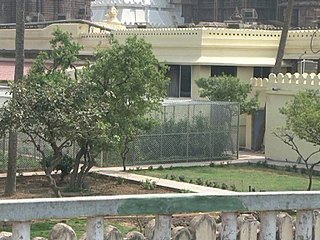
Nabakalebara also spelled as Navakalevara is the ritualistic recreation of the wooden icons of four Hindu deities at Jagannath Temple, Puri. The ritual is performed during the 8th, 12th, or 19th year after the previous Nabakalebara.

Brahmagiri is a town in Puri district, Odisha, India.The Vishnu Mandira.

The Adi Jagannatha Temple is a South Indian Hindu temple in Thiruppullani, a village in the outskirts of Ramanathapuram in the South Indian state of Tamil Nadu, is dedicated to the Hindu god Vishnu. It is believed that Rama used grass ('pul' in Tamil as a pillow to sleep and hence the village attained the name Thiruppullani. Constructed in the Dravidian style of architecture, the temple is glorified in the Naalayira Divya Prabandham, the early medieval Tamil canon of the Alvar saints from the 6th–9th centuries CE. It is one of the 108 Divya Desam dedicated to Vishnu, who is worshipped as Adi Jagannatha and his consort Lakshmi as Padmasini.

The Char Dham, also rendered the Chatur Dhama is a set of four pilgrimage sites in India. Since the establishment of the Char Dham temples, visiting these sites has become a path to achieve moksha. The four Dhams are Badrinath, Dwarka, Jagannath and Rameswaram.

The Bhima Devi Temple Complex, nicknamed Khajuraho of North India for its erotic sculptures, comprises the restored ruins of an ancient Hindu temple dating from between 8th and 11th century AD, together with the adjacent 17th-century Pinjore gardens, located in Pinjore town in Panchkula district of the state of Haryana, India. The old temple was destroyed by Islamic invaders and the present 8-11th CE temple is likely built on the same place under the old name, and the nearby ancient baoli still has old Hindu pillars. Bhimadevi belongs to the Shakti tradition that was derived from the Buddhist tantric goddess. Further, in the Devi Mahatmya it is said that in the Western Himalayas of Himachal Pradesh, Bhimadevi appeared in an enormous form of Bhimarupa and gave protection to the sages. The site was worked upon extensively by the team of Speaking Archaeologically from 2017 to 2019, with preliminary survey beginning as early as in 2015 and the report was published as the Speaking Archaeologically Journal Volume III:Bhima Devi Project Edition in 2020.

Chari Kshetra is a group of four holy regions in the Indian state of Odisha. According to tradition, when Vishnu killed the demon Gayasura, to commemorate the glory of his victory, he placed his shankha (conch) in Puri, chakra (discus) in Bhubaneswar, gada (mace) in Jajpur and padma (lotus) in Konark and they were known as Sankha Kshetra, Chakra Kshetra, Gada Kshetra, and Padma Kshetra respectively.
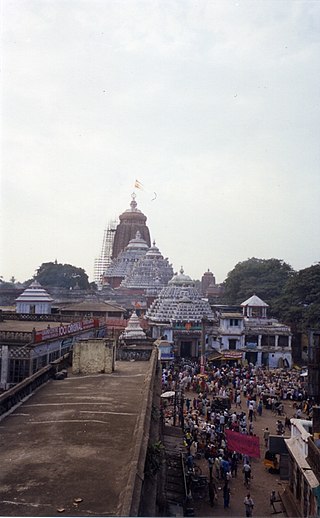
Nilachala, also rendered Niladri refers to a region corresponding to Puri, in the Indian state of Odisha.
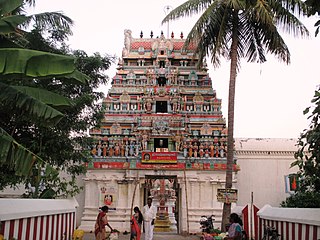
Nathan Kovil or Thiru Nandipura Vinnagaram Temple in Nathan Kovil, a village in the outskirts of Kumbakonam in the South Indian state of Tamil Nadu, is dedicated to the Hindu god Vishnu. Constructed in the Dravidian style of architecture, the temple is glorified in the Nalayira Divya Prabandham, the early medieval Tamil canon of the Alvar saints from the 6th–9th centuries CE. It is one of the 108 Divya Desams dedicated to Vishnu, who is worshipped as Jagannathan and his consort Lakshmi as Shenbagavalli.

Shri Shri Hari Baladev Jew Bije is a famous Hindu temple located in Baripada, Mayurbhanj district, in the state of Odisha, India. The name Jagannath is a combination of the Sanskrit words Jagat (Universe) and Nath.
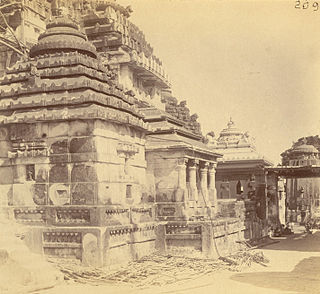
The Vimala Temple or Bimala Temple is a Hindu temple dedicated to goddess Vimala or Bimala (ବିମଳା), located within the Jagannath Temple complex in Puri in the Indian state of Odisha. It is generally regarded as a Shakti Pitha, among the holiest temples dedicated to the Hindu Goddess.
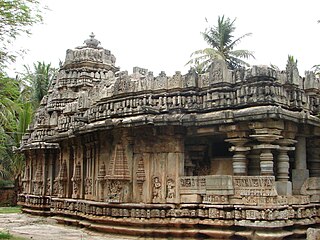
The Brahmeshvara temple, also referred to as the Brahmeshwara or Brahmesvara temple, is a 12th-century Hindu temple with Hoysala architecture in Kikkeri village, Mandya district of Karnataka state, India. Along with two other major historic temples within the village, the Brahmeshvara temple is one of many major ruined temples with notable artwork in Kikkeri area close to the more famous monuments of Shravanabelagola.
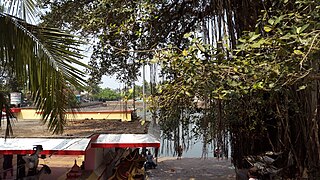
Hindus consider it essential to bathe in the Pancha Tirtha or the five sacred bathing spots of Puri, India, to complete a pilgrimage to Puri. The five sacred water bodies are:

Mahari is a ritualistic dance forms form the eastern Indian state of Odisha that used to be performed at the temple of Lord Jagannatha at Puri by devadasi dancers called maharis. Following the abolition of the devadasi system, the dance has been discontinued at the Jagannatha Temple but is now performed on stage at many venues. The Mahari dance spurred the development of both Odissi and the Gotipua dance forms of Odisha. The Maharis have been among the foremost exponents of both traditional Odia dance and Odissi music.

Maa Markama Temple located at Bissam Cuttack village of Rayagada district is a place of tourist interest. It is the only shrine of Devi Maa Markama and Maa karkama in the Indian state of Odisha. The temple of Maa Karkama is situated next to the temple of Maa Markama. The legend says that the Devi is being worshiped for centuries. However, the temple was constructed in the recent past. A junior college and a university college in Bissam Cuttack are named after Maa Markama. The temple is one of the places of tourist attractions in the Rayagada district. Dussehra and chaitra Paraba are celebrated every year at the temple. The nearest railhead is Chatikona, which is 7 km from Bissam Cuttack.

Jagannatha Perumal Temple (also called TirumaḻisaiTemple is dedicated to Hindu god Vishnu located in Tirumalisai, Chennai City, Tiruvallur district, in the South Indian state of Tamil Nadu. Constructed in the Dravidian style of architecture, dedicated to Vishnu, who is worshipped as Jagannatha Perumal and his consort Lakshmi as Thirumangaivalli. The temple is believed to be the birthplace of Thirumalisai Alvar, one of the twelve Alvars whose work is compiled as Divya Prabandha, the early medieval Tamil canon of the Alvar saints from the 6th–9th centuries CE. The temple is Classified one among the 108 Abhimana Kshethram of Vaishnavate tradition.
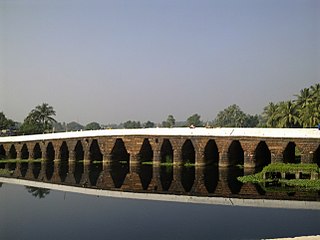
Atharanala - a historic laterite stone bridge over the Madhupur or Musa stream at the entrance to the city of Puri, Odisha (India) on Puri - Bhubaneswar road, locally known as Atharnala bridge; a Monument of National Importance N-OR-64 officially recognized by Archaeological Survey of India. Due to safety reasons the bridge is excluded from heavy vehicle traffic.




















